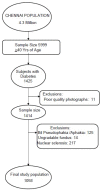Prevalence of myopia and its association with diabetic retinopathy in subjects with type II diabetes mellitus: A population-based study
- PMID: 22993463
- PMCID: PMC3441036
- DOI: 10.4103/0974-620X.99371
Prevalence of myopia and its association with diabetic retinopathy in subjects with type II diabetes mellitus: A population-based study
Abstract
Objective: To report the prevalence of myopia and its association with diabetic retinopathy in subjects with type II diabetes mellitus and compare the diabetic retinopathy status in the myopic group vs the emmetropic group.
Design: Population-based study.
Materials and methods: The population-based study estimated the prevalence of myopia from 1058 subjects, who were more than 40 years old and had type II diabetes mellitus; the patients were enrolled from a cross-sectional study. Participants answered a detailed questionnaire and underwent biochemical, physical and comprehensive ocular examination which included grading of nuclear sclerosis by lens opacities classification system III (LOCS III), seven field fundus photography and ultrasonography. Diabetic retinopathy and diabetic maculopathy were graded using the Klein's classification and early treatment diabetic retinopathy study (ETDRS) criteria respectively.
Results: The prevalence of mild, moderate and high myopia in type 2 diabetes was 15.9, 2.1 and 1.9% respectively. The prevalence of any myopia was found to be 19.9% in our study population. After adjusting the age, gender, duration of diabetes, hemoglobin A1c and other factors, increasing age was associated with mild and moderate myopia [OR 1.11 (95% CI 1.05 - 1.18)]. Compared to emmetropia, complete posterior vitreous detachment (CPVD) was associated with high myopia (50% Vs 12.2%, P < 0.0001). Myopia had no association with diabetic retinopathy.
Conclusion: The prevalence of myopia and high myopia was found to be 19.9 and 1.9% respectively among subjects with type II diabetes. Myopia was not associated with diabetic retinopathy, thereby, suggesting the need for a longitudinal study.
Keywords: Diabetes; high myopia; myopia.
Conflict of interest statement
Figures
Similar articles
-
Prevalence of posterior vitreous detachment in the population with type II diabetes mellitus and its effect on diabetic retinopathy: Sankara Nethralaya Diabetic Retinopathy Epidemiology and Molecular Genetic Study SN-DREAMS report no. 23.Jpn J Ophthalmol. 2012 May;56(3):262-7. doi: 10.1007/s10384-012-0134-7. Epub 2012 Apr 3. Jpn J Ophthalmol. 2012. PMID: 22476626
-
[Occurrence of changes in the eye in diabetic retinopathy with significant myopia].Srp Arh Celok Lek. 1998 Nov-Dec;126(11-12):457-60. Srp Arh Celok Lek. 1998. PMID: 9921019 Serbian.
-
Incidence, Progression, and Associated Risk Factors of Posterior Vitreous Detachment in Type 2 Diabetes Mellitus: Sankara Nethralaya Diabetic Retinopathy Epidemiology and Molecular Genetic Study (SN-DREAMS II, Report No. 7).Semin Ophthalmol. 2017;32(2):191-197. doi: 10.3109/08820538.2015.1047959. Epub 2015 Jul 6. Semin Ophthalmol. 2017. PMID: 26146895
-
Sankara Nethralaya Diabetic Retinopathy Epidemiology and Molecular Genetic Study (SN--DREAMS III): study design and research methodology.BMC Ophthalmol. 2011 Mar 24;11:7. doi: 10.1186/1471-2415-11-7. BMC Ophthalmol. 2011. PMID: 21435202 Free PMC article. Review.
-
A review of study designs and data analyses in metabolomics studies in myopia.Anal Biochem. 2022 Oct 15;655:114850. doi: 10.1016/j.ab.2022.114850. Epub 2022 Aug 13. Anal Biochem. 2022. PMID: 35970413 Review.
Cited by
-
Does myopia decrease the risk of diabetic retinopathy in both type-1 and type-2 diabetes mellitus?Indian J Ophthalmol. 2021 Nov;69(11):3178-3183. doi: 10.4103/ijo.IJO_1403_21. Indian J Ophthalmol. 2021. PMID: 34708767 Free PMC article.
-
Association between myopia and diabetic retinopathy: A two-sample mendelian randomization study.Adv Ophthalmol Pract Res. 2024 Oct 11;5(1):32-40. doi: 10.1016/j.aopr.2024.10.003. eCollection 2025 Feb-Mar. Adv Ophthalmol Pract Res. 2024. PMID: 39898361 Free PMC article.
-
Early detection of retinal and choroidal microvascular impairments in diabetic patients with myopia.Front Cell Dev Biol. 2025 May 26;13:1609928. doi: 10.3389/fcell.2025.1609928. eCollection 2025. Front Cell Dev Biol. 2025. PMID: 40491952 Free PMC article.
-
High myopia is protective against diabetic retinopathy via thinning retinal vein: A report from Fushun Diabetic Retinopathy Cohort Study (FS-DIRECT).Diab Vasc Dis Res. 2020 Jul-Aug;17(4):1479164120940988. doi: 10.1177/1479164120940988. Diab Vasc Dis Res. 2020. PMID: 32686483 Free PMC article.
-
The relationship between refractive error and the risk of diabetic retinopathy: a systematic review and meta-analysis.Front Med (Lausanne). 2024 Jun 4;11:1354856. doi: 10.3389/fmed.2024.1354856. eCollection 2024. Front Med (Lausanne). 2024. PMID: 38895184 Free PMC article.
References
-
- Lim LS, Lamoureux E, Saw SM, Tay WT, Mitchell P, Wong TY. Are myopic eyes less likely to have diabetic retinopathy? Ophthalmology. 2010;117:524–30. - PubMed
-
- Raman R, Rani PK, Reddi Rachepalle S, Gnanamoorthy P, Uthra S, Kumaramanickavel G, et al. Prevalence of diabetic retinopathy in India sankara nethralaya diabetic retinopathy epidemiology and molecular genetics study report 2. Ophthalmology. 2009;116:311–8. - PubMed
-
- Pierro L, Brancato R, Robino X, Lattanzio R, Jansen A, Calori G. Axial length in patients with diabetes. Retina. 1999;19:401–4. - PubMed
-
- Moss SE, Klein R, Klein BE. Ocular factors in the incidence and progression of diabetic retinopathy. Ophthalmology. 1994;101:77–83. - PubMed
-
- Rani PK, Raman R, Rachapalli SR, Kulothungan V, Kumaramanickavel G, Sharma T. Prevalence of refractive errors and associated risk factors in subjects with type 2 diabetes mellitus SN-DREAMS, report 18. Ophthalmology. 2010;117:1155–62. - PubMed
LinkOut - more resources
Full Text Sources


